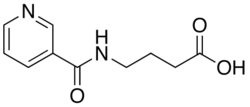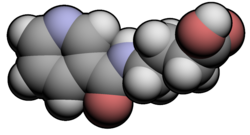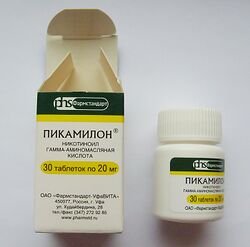Chemistry:Picamilon
 | |
 | |
| Clinical data | |
|---|---|
| Trade names | НПК ЭХО |
| Other names | nicotinoyl-GABA |
| Routes of administration | Oral |
| ATC code | |
| Legal status | |
| Legal status | |
| Pharmacokinetic data | |
| Bioavailability | 50%–88% |
| Elimination half-life | 30 minutes |
| Excretion | Renal |
| Identifiers | |
| |
| CAS Number | |
| PubChem CID | |
| ChemSpider | |
| UNII | |
| Chemical and physical data | |
| Formula | C10H12N2O3 |
| Molar mass | 208.217 g·mol−1 |
| 3D model (JSmol) | |
| |
| |
| | |
Picamilon (also known as N-nicotinoyl-GABA, pycamilon, and pikamilon) is a drug formed by a synthetic combination of niacin and γ-aminobutyric acid (GABA). It was developed in the Soviet Union in 1969[2] and further studied in both Russia [3] and Japan as a prodrug of GABA.[4]
In Russia, picamilon is sold as a prescription drug. The rights to the drug belong to the Russian pharmaceutical company NPK ECHO ("НПК ЭХО"). It is not approved for sale in the United States and has been deemed an adulterating agent in dietary supplements,[5] with five American companies required to remove their picamilon products from the market in November, 2015.[6] However, as recently as 2020, picamilon has been found in pharmaceutical dosages in over-the-counter supplements in the US.[7]
Mechanism of action and potential therapeutic applications
One study in animals showed that picamilon permeated the blood–brain barrier[8] and then is hydrolyzed into GABA and niacin.[9] The released GABA in theory would activate GABA receptors, potentially producing an anxiolytic response.[10] The second released component, niacin, is a vasodilator.[11][12]
Detection in biological fluids
Plasma picamilon concentrations are generally in the 500–3000 μg/L range during the first few hours after single oral doses of 50–200 mg with a half-life of 1–2 hours.[13] The drug undergoes hydrolysis to GABA and nicotinic acid. Urinary excretion of parent drug and the two metabolites accounts for up to 79% of a single dose.[13]

Regulation
In the United States, the Food and Drug Administration ruled in 2015 that picamilon does not fit any of the dietary ingredient categories in the Dietary Supplement Health and Education Act of 1994,[6][14] namely that it is not a vitamin; a dietary mineral; an herb or other botanical; an amino acid; a dietary substance for use by humans to supplement the diet by increasing the total dietary intake; or a concentrate, metabolite, constituent, extract, or combination of any ingredient described above that had been marketed in the United States before 1994. Despite the FDA ruling, picamilon remains an ingredient in supplements marketed as nootropics in the US.[7]
References
- ↑ "Picamilon in Dietary Supplements". November 29, 2017. https://www.fda.gov/food/dietary-supplement-ingredient-directory/picamilon-dietary-supplements.
- ↑ "Some approaches to the directed search for new drugs based on nicotinic acid". Pharmaceutical Chemistry Journal 33 (4): 177–187. April 1999. doi:10.1007/BF02509934.
- ↑ "[The new cerebrovascular preparation pikamilon]" (in ru). Farmakologiia I Toksikologiia 52 (1): 23–6. 1989. PMID 2707413.
- ↑ "Evaluation of isonicotinoyl-gamma-aminobutyric acid (GABA) and nicotinoyl-GABA as pro-drugs of GABA". Chemical & Pharmaceutical Bulletin 32 (10): 4089–95. October 1984. doi:10.1248/cpb.32.4089. PMID 6529802.
- ↑ "Identification and quantification of vinpocetine and picamilon in dietary supplements sold in the United States". Drug Testing and Analysis 8 (3–4): 334–43. March 2016. doi:10.1002/dta.1853. PMID 26426301.
- ↑ 6.0 6.1 "FDA sends five warning letters over supplements containing picamilon". NutraIngredients-USA.com, William Reed Business Media. 2 December 2015. http://www.nutraingredients-usa.com/Regulation/FDA-sends-five-warning-letters-over-supplements-containing-picamilon/?c=7InNqGv0AjdjxWpyk%2BfGQw%3D%3D&p2=.
- ↑ 7.0 7.1 "Five Unapproved Drugs Found in Cognitive Enhancement Supplements". Neurology. Clinical Practice 11 (3): e303–e307. June 2021. doi:10.1212/CPJ.0000000000000960. PMID 34484905.
- ↑ "[Pikamilon pharmacokinetics in animals]" (in ru). Farmakologiia I Toksikologiia 54 (2): 66–9. 1991. PMID 1884802.
- ↑ "Technical Description of Picamilon". http://picamilon.org/.
- ↑ "Behavioral effects of GABA agonists in relation to anxiety and benzodiazepine action". Life Sciences 40 (25): 2429–36. June 1987. doi:10.1016/0024-3205(87)90758-2. PMID 2884549.
- ↑ "Nicotinic acid: pharmacological effects and mechanisms of action". Annual Review of Pharmacology and Toxicology 48: 79–106. 2008. doi:10.1146/annurev.pharmtox.48.113006.094746. PMID 17705685.
- ↑ "The treatment of migraines and tension-type headaches with intravenous and oral niacin (nicotinic acid): systematic review of the literature". Nutrition Journal 4: 3. January 2005. doi:10.1186/1475-2891-4-3. PMID 15673472.
- ↑ 13.0 13.1 "Determination of picamilon concentration in human plasma by liquid chromatography-tandem mass spectrometry". Journal of Chromatography B 878 (15–16): 1181–4. May 2010. doi:10.1016/j.jchromb.2010.03.013. PMID 20359966.
- ↑ Welch, Cara. "Declaration of Dr. Cara Welch". Department of Health and Human Services. https://blog.priceplow.com/wp-content/uploads/Picamilon-FDA_Ruling-20150928.pdf.
External links
- nicotinoyl-GABA at the US National Library of Medicine Medical Subject Headings (MeSH)
{{Navbox | name = GABA receptor modulators | title = GABA receptor modulators | state = collapsed | bodyclass = hlist | groupstyle = text-align:center;
| group1 = Ionotropic | list1 = {{Navbox|subgroup | groupstyle = text-align:center | groupwidth = 5em
| group1 = GABAA | list1 =
- Agonists: (+)-Catechin
- Bamaluzole
- Barbiturates (e.g., phenobarbital)
- BL-1020
- DAVA
- Dihydromuscimol
- GABA
- Gabamide
- GABOB
- Gaboxadol (THIP)
- Homotaurine (tramiprosate, 3-APS)
- Ibotenic acid
- iso-THAZ
- iso-THIP
- Isoguvacine
- Isomuscimol
- Isonipecotic acid
- Kojic amine
- Lignans (e.g., honokiol)
- Methylglyoxal
- Monastrol
- Muscimol
- Nefiracetam
- Neuroactive steroids (e.g., allopregnanolone)
- Org 20599
- PF-6372865
- Phenibut
- Picamilon
- P4S
- Progabide
- Propofol
- Quisqualamine
- SL-75102
- TACA
- TAMP
- Terpenoids (e.g., borneol)
- Thiomuscimol
- Tolgabide
- ZAPA
- Positive modulators (abridged; see here for a full list): α-EMTBL
- Alcohols (e.g., ethanol)
- Anabolic steroids
- Avermectins (e.g., ivermectin)
- Barbiturates (e.g., phenobarbital)
- Benzodiazepines (e.g., diazepam)
- Bromide compounds (e.g., potassium bromide)
- Carbamates (e.g., meprobamate)
- Carbamazepine
- Chloralose
- Chlormezanone
- Clomethiazole
- Dihydroergolines (e.g., ergoloid (dihydroergotoxine))
- Etazepine
- Etifoxine
- Fenamates (e.g., mefenamic acid)
- Flavonoids (e.g., apigenin, hispidulin)
- Fluoxetine
- Flupirtine
- Imidazoles (e.g., etomidate)
- Kava constituents (e.g., kavain)<!--PMID: 9776662-->
- Lanthanum
- Loreclezole
- Monastrol
- Neuroactive steroids (e.g., allopregnanolone, [[Chemistry:Cholecholesterol]], THDOC)
- Niacin
- Nicotinamide (niacinamide)
- Nonbenzodiazepines (e.g., β-carbolines (e.g., [[abecarnil), cyclopyrrolones (e.g., zopiclone), imidazopyridines (e.g., zolpidem), pyrazolopyrimidines (e.g., zaleplon))
- Norfluoxetine
- Petrichloral
- Phenols (e.g., propofol)
- Phenytoin
- Piperidinediones (e.g., glutethimide)
- Propanidid
- Pyrazolopyridines (e.g., etazolate)
- Quinazolinones (e.g., methaqualone)
- Retigabine (ezogabine)
- ROD-188
- Skullcap constituents (e.g., baicalin)
- Stiripentol
- Sulfonylalkanes (e.g., sulfonmethane (sulfonal))
- Topiramate
- Valerian constituents (e.g., valerenic acid)
- Volatiles/gases (e.g., chloral hydrate, chloroform, [[Chemistry:Diethyl diethyl ether, Parparaldehyde]], sevoflurane)
- Antagonists: Bicuculline
- Coriamyrtin
- Dihydrosecurinine
- Gabazine (SR-95531)
- Hydrastine
- Hyenachin (mellitoxin)
- PHP-501
- Pitrazepin
- Securinine
- Sinomenine
- SR-42641
- SR-95103
- Thiocolchicoside
- Tutin
- Negative modulators: 1,3M1B
- 3M2B
- 11-Ketoprogesterone
- 17-Phenylandrostenol
- α5IA (LS-193,268)
- β-CCB
- β-CCE
- β-CCM
- β-CCP
- β-EMGBL
- Anabolic steroids
- Amiloride
- Anisatin
- β-Lactams (e.g., penicillins, cephalosporins, carbapenems)
- Basmisanil
- Bemegride
- Bicyclic phosphates (TBPS, TBPO, IPTBO)
- BIDN
- Bilobalide
- Bupropion
- CHEB
- Chlorophenylsilatrane
- Cicutoxin
- Cloflubicyne
- Cyclothiazide
- DHEA
- DHEA-S
- Dieldrin
- (+)-DMBB
- DMCM
- DMPC
- EBOB
- Etbicyphat
- FG-7142 (ZK-31906)
- Fiproles (e.g., fipronil)
- Flavonoids (e.g., amentoflavone, oroxylin A)
- Flumazenil
- Fluoroquinolones (e.g., ciprofloxacin)
- Flurothyl
- Furosemide
- Golexanolone
- Iomazenil (123I)
- IPTBO
- Isopregnanolone (sepranolone)
- L-655,708
- Laudanosine
- Leptazol
- Lindane
- MaxiPost
- Morphine
- Morphine-3-glucuronide
- MRK-016
- Naloxone
- Naltrexone
- Nicardipine
- Nonsteroidal antiandrogens (e.g., [[apalutamide, [[Chemistry:Bicalutbicalutamide, Enzalutenzalutamide, Chemistry:Flutamide|flut]]amide]], nilutamide)
- Oenanthotoxin
- Pentylenetetrazol (pentetrazol)
- Phenylsilatrane
- Picrotoxin (i.e., picrotin, picrotoxinin and dihydropicrotoxinin)
- Pregnenolone sulfate
- Propybicyphat
- PWZ-029
- Radequinil
- Ro 15-4513
- Ro 19-4603
- RO4882224
- RO4938581
- Sarmazenil
- SCS
- Suritozole
- TB-21007
- TBOB
- TBPS
- TCS-1105
- Terbequinil
- TETS
- Thujone
- U-93631
- Zinc
- ZK-93426
| group2 = GABAA-ρ | list2 =
- Agonists: BL-1020
- CACA
- CAMP
- Homohypotaurine
- GABA
- GABOB
- Ibotenic acid
- Isoguvacine
- Muscimol
- N4-Chloroacetylcytosine arabinoside
- Picamilon
- Progabide
- TACA
- TAMP
- Thiomuscimol
- Tolgabide
- Positive modulators: Allopregnanolone
- Alphaxolone
- ATHDOC
- Lanthanides
- Antagonists: (S)-2-MeGABA
- (S)-4-ACPBPA
- (S)-4-ACPCA
- 2-MeTACA
- 3-APMPA
- 4-ACPAM
- 4-GBA
- cis-3-ACPBPA
- CGP-36742 (SGS-742)
- DAVA
- Gabazine (SR-95531)
- Gaboxadol (THIP)
- I4AA
- Isonipecotic acid
- Loreclezole
- P4MPA
- P4S
- SKF-97541
- SR-95318
- SR-95813
- TPMPA
- trans-3-ACPBPA
- ZAPA
- Negative modulators: 5α-Dihydroprogesterone
- Bilobalide
- Loreclezole
- Picrotoxin (picrotin, picrotoxinin)
- Pregnanolone
- ROD-188
- THDOC
- Zinc
}}
| group2 = Metabotropic
| list2 =
| below =
- See also
- Receptor/signaling modulators
- GABAA receptor positive modulators
- GABA metabolism/transport modulators
}}
 |
